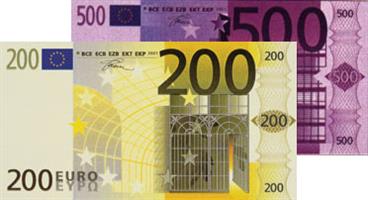RFID banknotes
In 2001, the European Central Bank started working with technology partners on a hush-hush
project to embed radio frequency identification tags into the very fibers of euro banknotes by 2005. The ECB
was deeply concerned about counterfeiting and money laundering. Counterfeiting of euro notes has been a problem
in Greece and there have been cases in the new member countries too. In 2003, Greek authorities were confronted
with of 2,411 counterfeiting cases and seized 4,776 counterfeit banknotes while authorities in Poland nabbed a
gang suspected of making and putting over a million fake euros into circulation. Money laundering was also an
issue of increasing concern, and that was probably one of the reasons that the higher denominations were
considered for tagging (€200 and €500 notes).

Although euro banknotes already include such security features as holograms, foil
stripes, special threads, microprinting, special inks and watermarks, the ECB believes it must add further protection
to keep the euro from becoming the currency of choice in the criminal underworld. Among the current security
features are threads visible under ultraviolet light, but businesses and stores often find it hard to judge a
note's authenticity, as current equipment seldom can tell the difference between false currency and old notes
with worn-out security marks. The ECB has contacted various central banks worldwide - not just in Europe - to
discuss added security measures for the currency.
According to the banking community and chip suppliers, the integration of an RFID antenna and
chip on a banknote is technically possible, but no banknotes in the world today employ such a technology. On
the other hand, critics say it's unclear if the technology can be implemented at a cost that can justify the
effort, and question whether it is robust enough to survive the rough-and-tumble life span of paper money. A
spokesman for the European Central Bank (ECB) in Frankfurt, Germany confirmed the existence of a project, but
was careful not to comment on its technologies. In theory, an RFID tag's ability to read and write information
to a banknote could make it very difficult, for example, for kidnappers to ask for "unmarked" bills. Further, a
tag would give governments and law enforcement agencies a means to literally "follow the money" in illegal
transactions.
RFID basics
The basic technology building blocks for RFID on banknotes are similar to those required for
today's smart labels or contactless cards. They require a contactless data link that can automatically collect
information about a product, place, time or transaction. Smart labels produced by companies such as Philips
Semiconductors, Infineon, STMicroelectronics and Texas Instruments are already used in such applications as
smart airline luggage tags, library books and for supply chain management of various products.
When a banknote passes through reader equipment, the antenna on the note collects energy and
converts it to electric energy to activates the chip. The antenna then provides a communication path between a
chip on the banknote and the rest of the world. For its part, the chip is a dedicated processor to handle
protocols, to carry out data encoding to send and receive data and address memory embedded on the chip.
Challenges and problems
A number of challenges must be overcome before RFID tags can be embedded on bills, said Kevin
Ashton, executive director of the Auto ID Center at the Massachusetts Institute of Technology. "The most obvious
one is the price," he said. Today's RFID tags cost between 20 cents to $1.00, and "that's not economic enough for
most bills," Ashton said. While most chip companies with RFID expertise are keeping their plans for money
applications close to their chest, Hitachi Ltd. announced plans for a chip designed for paper money that would
pack RF circuitry and ROM in a 0.4-mm square circuit measuring 60 microns thick. In 2004, the ECB reportedly
started talks with Hitachi, and so has the The Bank of Japan, that is considering RFID tags for its 10,000-yen
banknotes.
It is unclear whether the ECB will incorporate RFID chips into all euro banknotes or just on
the larger bills. The EUR 200 and EUR 500 banknotes in particular are expected to be popular in the "informal"
economy. Embedding a 30 cents chip into a EUR 500 bill would make more sense than putting it into a European
buck, several industry sources said. There is also the issue of trust. Putting RFID tags in currency would be
seen as a breach of privacy, as there would be a temptation to use it to track purchases and transactions in
order to trace banknotes for fiscal reasons. Would the users confide in the ECB not tracking their transactions?
Tracking euro notes could prove to be exceedingly difficult, simply because many transactions
are informal in their nature, and the change of ownership of individual notes is not recorded between for
instance friends, relatives, and spouses. Many transactions inside companies are also more informal in nature,
and do not have to involve any foul play, and even if it was mandated by law that all companies put tag readers
in their cash registers to track the bills, this would not be very hard to get around.